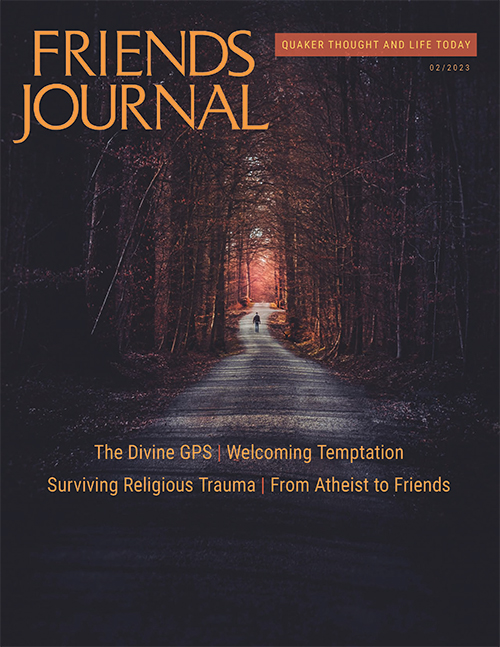A Fresh Introduction to Jesus
When I left home to go to nursing school, I abandoned my childhood Jesus like a teddy bear that ends up in a box in the attic. I didn’t think about him much afterward. During my decades attending Quaker meetings, I rarely heard Jesus’s name mentioned and only on occasion heard reference to the gospels.
While over the years my connection with Spirit has been growing, my concept of Jesus never developed beyond the colorful pictures from my Baptist Sunday School literature of a pleasant-looking man talking to children or holding a lamb. The songs I learned about Jesus loving me and loving the children of all colors around the world were nice but had little impact on shaping my concept of him.
By chance (or not), my longtime friend sent me a copy of The Pilgrim Way of Lent, a book that her Episcopal church was reading and discussing for Lent. Each day, except for Sundays, a short Bible passage was featured, as was a brief commentary by clergy from the National Cathedral in Washington, D.C., and a few lines of prayer, many from the Book of Common Prayer, which was a resource unfamiliar to me.
During the first week, we were introduced to a biblical account of Jesus’s response when someone asked who he was. He answered, “Come and see.” He was encouraging experience rather than a pat set of answers.
The label “Christian” had been tarnished for me by people who insisted their vision was the only truth and seemed to abandon Jesus’s message of love and compassion. But last year, because I know that around 2.3 billion people in the world claim to be Christian and because the roots of Quakerism arise out of Christianity, I decided it was time to learn more about Jesus, a man who was acknowledged to be at least a historical figure, if not more.
My notion of Lent was very sketchy. I remembered it as a time when Catholic friends of mine got ashes smudged on their foreheads and sacrificed eating chocolate for six weeks. I was unfamiliar with any of the language, the specific events, or the religious meaning of those events.
Through the miracle of Zoom, I was able to participate in an exploration and an honoring of Jesus with a small group of Episcopalians in North Carolina for whom Lent was an important commemoration of the life of Jesus. During the first week, we were introduced to a biblical account of Jesus’s response when someone asked who he was. He answered, “Come and see.” He was encouraging experience rather than a pat set of answers. That’s where the group started its journey: coming daily and seeing Jesus. Each day, the priest who led the group guided us through the text but also facilitated our own thinking and reflections on the material. The group members were welcoming, honest, and very open.

Photo by Priscilla du Preez on Unsplash
Since I was unfamiliar with high-church thinking or practices, I conscripted my partner, a graduate of 12 years of Catholic school and service as an altar boy, to explain certain theological subtleties and rituals to me. Although some people would label him “lapsed,” I was surprised by his familiarity with Scripture and theology. He was patient with my questions, which ranged from the practices of Ash Wednesday to why the day of crucifixion is called “good.” Over the course of these discussions, I developed a more mature vision of Jesus. Some messages were familiar and comforting, like loving one another, even my enemies, and doing unto others as I would have them to do unto me. But other things I learned were surprising. Jesus did not hang out at the Temple with the priests and other religious officials but spent time with all classes of people, including women. He even associated with people who most Jewish people avoided, like the tax collectors and Samaritans, and told stories about them that showed them in a favorable light. He didn’t always follow the rules (he healed people on the Sabbath) but proclaimed that he was not sent to abolish the Jewish law and create a new religion but to fulfill the Hebraic prophets and laws.
The Scriptures also told of Jesus spending long hours in prayer and meditation and, at the same time, being capable of having quite a temper. I was familiar with the story of Jesus clearing the Temple of the money changers, but the scene was much more vivid and dramatic than I realized. Jesus made a whip out of cords to drive out the money changers; released the animals there for sale; poured out the merchants’ money on the floor; and overturned the tables that were set up, declaring that his house would be a house of prayer.
Jesus gathered a crowd of followers, in part because of the miracles he performed. While some people doubted the miracles, those who had been cured confirmed his powers. At times, crowds of Jews tried to stone him because they accused him of saying he was God, but he managed to slip away.
Throughout his ministry, Jesus offered many teachings and much wisdom. Sometimes they were enigmatic or contrary to what people were expecting, but ultimately his message was about love—he said that his followers would be known by how they loved one another.
As with any fresh introduction, I don’t pretend to know the depth of this person, Jesus. I can imagine him fully filled with the Light, but I don’t have much of an understanding of the word “Christ.” Nevertheless I am glad to make his acquaintance and include him in my spiritual journey, and I look forward to a growing relationship.
On Palm Sunday, I thought about the discussions in the group for the upcoming week. Then, in a flash, I had a felt sense of Jesus, and with pain, I experienced a real loss. I understood for the first time the significance of a human being who was fully imbued with Spirit. He knew all the human emotions: celebration, companionship, abandonment, disappointment, and betrayal. His Spirit was one I could turn to in order to understand my very human needs. I said to my partner, “This is not going to end well. Officials are going to arrest him, question him, and then they’re going to kill him.” “Yes,” he answered, “but he’ll come back.”
And he did, at least according to our reading. Jesus predicted his death and resurrection. After his tomb was found empty, a number of people saw him, and Thomas even touched his wounds. This event is a sticking point for some people. Either they insist on resurrection as a testament to being a follower of Jesus, or they completely reject it. For me, his teaching and his serving as a role model are great ways for me to start to get to know him better.
As with any fresh introduction, I don’t pretend to know the depth of this person, Jesus. I can imagine him fully filled with the Light, but I don’t have much of an understanding of the word “Christ.” Nevertheless I am glad to make his acquaintance and include him in my spiritual journey, and I look forward to a growing relationship. I have a lot more to learn from him: this Son of Man, this Son of God.





I cannot tell you how much I appreciate this article. My childhood included those same stories, but I never even began to *meet* Jesus. During my last 20 years as a Quaker I have *fellowshipped* regularly with people from Catholic, Episcopal, UCC, and other *Christian* churches. I have developed a loving relationship with my Creator, Spirit, God, and close connection with the Holy Spirit. However, I do not identify as Christian because of not *believing* in Jesus, the Christ. I regularly observe Lent with my Christian companions and loved reading of your experience. Thank you.
I love what I know of Jesus, but I am puzzled why did he come to earth? and what does it mean to be the son of God? and why did he have to die? and is it bad for someone to die? and why does he have to be rise from the dead? and then to go to heaven, why did he not prefer to just tunnel through the earth? is the earth bad and is heaven good? Or, why did Jesus say “blessed are the meek for they shall inherit the earth? who are the meek and where can we find them, are the quaker friends meek? too many questions…..a long time is needed perhaps?
I was raised as an Episcopalian and my mother was devout. Although I loved the principles of Christianity as they were presented to me throughout my youth, in many ways, I came to feel that the ‘church’ stood between me and the Jesus I understood. Our original Episcopalian Church was Gloria Dei, Old Swede’s Church in Philadelphia and our reverend was an ethics based speaker who tied bible readings to real world behavior. But we moved, and church changed for me. The rotating cast of ministers in our new church, with a falling membership, seemed hollow, as though they were playing a part, not living a creed. I eft the Episcopalian church and tried any others including Congregational, Baptist, and Unitarian, then I found the Society of Friends. Here I found Jesus in the members. It wasn’t about the institution, but the soul and the heart. In the Society of Friends I discovered something else. In the other churches, the whole spirit of the place depended on the particular minister presiding, but in the Society of Friends, I found the spirit present in the different Meetings I attended. It was a living, ‘soulful’ presence,
Marking the events in the life of Jesus from his healing, teaching, death and resurrection is one way to an inner transformation of our lives through the action of the (Holy) Spirit. Whether in silent Quaker worship or in a liturgical worship we are ultimately drawn to an Inner Teacher, to the judgment and discernment of the Most Wise.